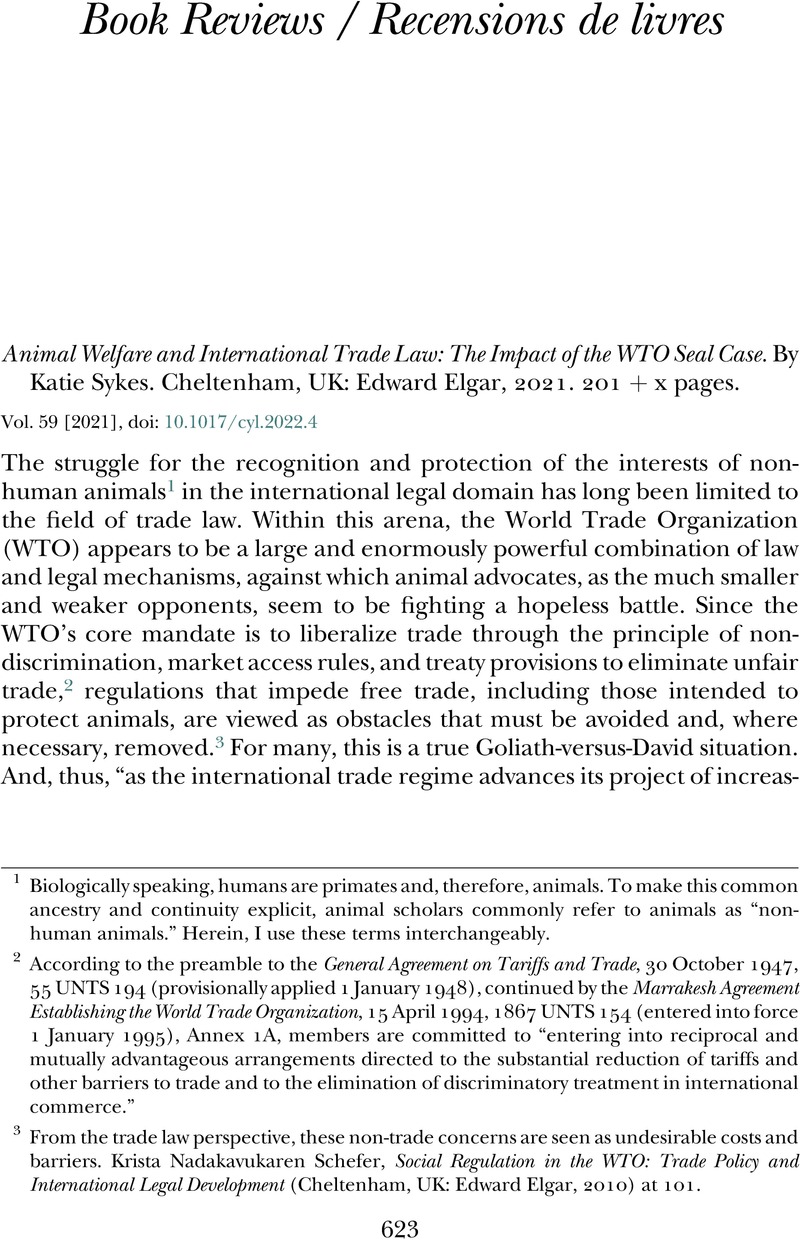No CrossRef data available.
Published online by Cambridge University Press: 25 March 2022

1 Biologically speaking, humans are primates and, therefore, animals. To make this common ancestry and continuity explicit, animal scholars commonly refer to animals as “non-human animals.” Herein, I use these terms interchangeably.
2 According to the preamble to the General Agreement on Tariffs and Trade, 30 October 1947, 55 UNTS 194 (provisionally applied 1 January 1948), continued by the Marrakesh Agreement Establishing the World Trade Organization, 15 April 1994, 1867 UNTS 154 (entered into force 1 January 1995), Annex 1A, members are committed to “entering into reciprocal and mutually advantageous arrangements directed to the substantial reduction of tariffs and other barriers to trade and to the elimination of discriminatory treatment in international commerce.”
3 From the trade law perspective, these non-trade concerns are seen as undesirable costs and barriers. Schefer, Krista Nadakavukaren, Social Regulation in the WTO: Trade Policy and International Legal Development (Cheltenham, UK: Edward Elgar, 2010) at 101 CrossRefGoogle Scholar.
4 Sykes, Katie, Animal Welfare and International Trade Law: The Impact of the WTO Seal Case (Cheltenham, UK: Edward Elgar, 2021) at 3CrossRefGoogle Scholar.
5 The World Trade Organization’s (WTO) priority is to settle disputes, preferably through a mutually agreed solution but, if not, then through adjudication. See Article 3.7 of the WTO’s Understanding on the Rules and Procedures Governing the Settlement of Disputes, 15 April 1994, 1869 UNTS 401 (entered into force 1 January 1995).
6 Sykes, supra note 4 at 2.
7 European Communities – Measures Prohibiting the Importation and Marketing of Seal Products, WTO Doc WT/DS400/R, WT/DS4001/R (Panel Report) (circulated 25 November 2013, adopted 18 June 2014 respectively) [Seal Products].
8 Ibid at paras 7.420, 7.409. As noted in footnote 16 of the report, the panel received a submission co-authored by Sykes with Robert Howse and Joanna Langille.
9 European Communities – Measures Prohibiting the Importation and Marketing of Seal Products, WTO Doc WT/DS400/AB/R, WT/DS401/AB/R (Appellate Body Report) (circulated 22 May 2014, adopted 18 June 2014 respectively).
10 See further Blattner, Charlotte E, Protecting Animals within and across Borders: Extraterritorial Jurisdiction and the Challenges of Globalization (New York: Oxford University Press, 2019)CrossRefGoogle Scholar; Peters, Anne, Animals in International Law (Leiden: Brill, 2021)CrossRefGoogle Scholar; Katie Sykes, “Sealing Animal Welfare into the GATT Exceptions” (2014) 13 World Trade Rev 471. See also the forthcoming special issue of the Global Journal of Animal Law, edited by guest editors Kathy Hessler, Sophie Riley, Joan Schaffner, and Geoffrey Wandesforde-Smith.
11 Sykes, supra note 4 at 14.
12 Charlotte E Blattner, “An Assessment of Recent Trade Law Developments from an Animal Law Perspective: Trade Law as the Sheep in the Wolf’s Clothing?” (2016) 22:2 Animal L Rev 277.
13 Brunnée, Jutta & Toope, Stephen J, Legitimacy and Legality in International Law: An Interactional Account (Cambridge: Cambridge University Press, 2010)CrossRefGoogle Scholar.
14 26 June 1945, Can TS 1945 No 7 (entered into force 24 October 1945).
15 Blattner, supra note 10 at 2.
16 Sykes, supra note 4 at 44.
17 Peters, Anne, “Global Animal Law: What It Is and Why We Need It” (2016) 5:1 Transnational Environmental L 9 at 20 Google Scholar.
18 See further Sykes, Katie, “Globalization and the Animal Turn: How International Trade Law Contributes to Global Norms of Animal Protection” (2016) 5:1 Transnational Environmental L 55 CrossRefGoogle Scholar.
19 See Terrestrial Animal Health Code (Paris: World Organisation for Animal Health, 2021), section 7; Aquatic Animal Health Code (Paris: World Organisation for Animal Health, 2021), section 7, online: <www.oie.int/en/what-we-do/standards/codes-and-manuals/>.
20 Prominent examples include the six conventions adopted by states under the auspices of the Council of Europe: European Convention for the Protection of Animals during International Transport (Revised), 6 November 2003, CETS No 193 (entered into force 14 March 2006); European Convention for the Protection of Pet Animals, 13 November 1987, CETS No 125 (entered into force 1 May 1992); European Convention for the Protection of Vertebrate Animals Used for Experimental and Other Scientific Purposes, 18 March 1986, CETS No 123 (entered into force 1 January 1991); Convention on the Conservation of European Wildlife and Natural Habitats, 19 September 1982, CETS No 104 (entered into force 1 June 1982); European Convention for the Protection of Animals for Slaughter, 10 May 1979, CETS No 102 (entered into force 11 June 1982); European Convention for the Protection of Animals Kept for Farming Purposes, 10 March 1976, ETS No 087 (entered into force 10 September 1978).
21 Prominent examples include proposals for an International Convention for the Protection of Animals, online: <www.animallaw.info/treaty/international-convention-protection-animals>, a UN Convention on Animal Health and Protection, online: <www.uncahp.org/>, and the most recent proposal for a Convention on Animal Protection for Public Health, Animal Welfare, and the Environment, online: <www.conventiononanimalprotection.org/the-cap-treaty>. See also the proposals for a Universal Declaration of Animal Rights and a Universal Declaration on Animal Welfare.
22 Sykes, supra note 4 at 63.
23 “Hunting for Logic in the WTO’s Seal-Hunt Ruling,” editorial, Globe and Mail (1 December 2013).
24 Adopted in Auckland on 4 February 2016.
25 8 March 2018, online: <www.international.gc.ca/tradecommerce/trade-agreements-accords-commerciaux/agr-acc/tpp-ptp/text-texte/toc-tdm> (entered into force 30 December 2018 for Canada, Australia, Japan, Mexico, New Zealand, Singapore; entered into force 14 January 2019 for Vietnam).
26 Canada-European Union Comprehensive Economic and Trade Agreement, 30 October 2016, online: <trade.ec.europa.eu/doclib/docs/2014/september/tradoc_152806.pdf> (provisionally applied 21 September 2017).
27 Sykes, supra note 4 at 190.
28 Ibid at 154.
29 For a critique, see Iyan Offor, “Animals and the Impact of Trade Law and Policy: A Global Animal Law Question” (2020) 9:2 Transnational Environmental L 239.